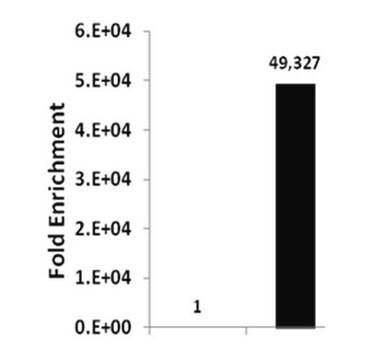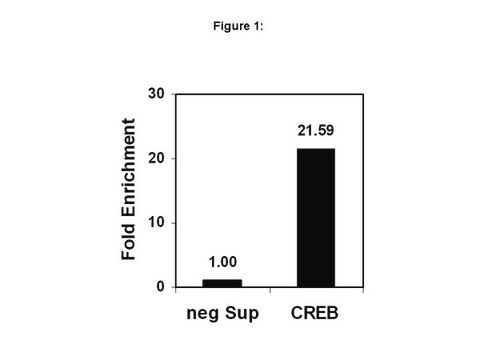17-10057
ChIPAb+ SMRT - ChIP Validated Antibody and Primer Set
ascites fluid, from mouse
Synonyme(s) :
CTG repeat protein 26, Silencing mediator of retinoic acid and thyroid hormone receptor, T3 receptor-associating factor, Thyroid-, retinoic-acid-receptor-associated corepressor, nuclear receptor co-repressor 2, silencing mediator for retinoid and thyroid
About This Item
Produits recommandés
Source biologique
mouse
Niveau de qualité
Forme d'anticorps
ascites fluid
Clone
monoclonal
Espèces réactives
human, mouse, rat
Fabricant/nom de marque
ChIPAb+
Upstate®
Technique(s)
ChIP: suitable
electrophoretic mobility shift assay: suitable
immunocytochemistry: suitable
immunohistochemistry: suitable
immunoprecipitation (IP): suitable
western blot: suitable
Isotype
IgG2aκ
Numéro d'accès NCBI
Numéro d'accès UniProt
Conditions d'expédition
dry ice
Informations sur le gène
human ... NCOR2(9612) , TRAC(28755)
Description générale
The ChIPAb+ SMRT set includes the SMRT antibody, a negative control mouse ascites, and qPCR primers which amplify a 299 bp region of human IκBα promoter. The SMRT and negative controls are supplied in a scalable "per ChIP" reaction size and can be used to functionally validate the precipitation of SMRT-associated chromatin.
Spécificité
Immunogène
Application
Sonicated chromatin prepared from serum starved, TNFα treated (20 ng/mL, 30 min) HeLa cells (~3 X 106 cell equivalents per IP) were subjected to chromatin immunoprecipitation using 2 µL of Negative Ascites or 2 µL Anti-SMRT) and the Magna ChIP G Kit (Cat. # 17-611).
Successful immunoprecipitation of SMRT associated DNA fragments was verified by qPCR using ChIP Primers, IĸBα promoter as a positive locus, and β-Actin promoter primers as a negative locus (Please see figures).
Data is presented as percent input of each IP sample relative to input chromatin for each amplicon and ChIP sample as indicated.
Please refer to the EZ-Magna ChIP A (Cat. # 17-408) or EZ-ChIP (Cat. # 17-371) protocol for experimental details.
Western Blot Analysis:
Representative lot data.
Human brain lysate was resolved by electrophoresis, transferred to PVDF membranes and probed with Anti-SMRT (1:1000 dilution).
Proteins were visualized using a Goat Anti-Mouse IgG conjugated to HRP and a chemiluminescence detection system (Please see figures).
Epigenetics & Nuclear Function
RNA Metabolism & Binding Proteins
Conditionnement
Qualité
Sonicated chromatin prepared from serum starved, TNFα treated (20 ng/mL, 30 min) HeLa cells (~3 X 106 cell equivalents per IP) were subjected to chromatin immunoprecipitation using 2 µL of Negative Ascites or 2 µL Anti-SMRT) and the Magna ChIP® G Kit (Cat. # 17-611).
Successful immunoprecipitation of SMRT associated DNA fragments was verified by qPCR using ChIP Primers, IĸBα promoter (Please see figures).
Please refer to the EZ-Magna ChIP A (Cat. # 17-408) or EZ-ChIP (Cat. # 17-371) protocol for experimental details.
Description de la cible
Forme physique
Negative Ascites (mouse). One vial containing 50 µL of mouse ascites with 0.05% sodium azide. Store at -20°C.
ChIP Primers, IκBα promoter. One vial containing 75 μL of 5 μM of each primer specific for human IĸBα promoter. Store at -20°C.
FOR: GAC GAC CCC AAT TCA AAT CG
REV: TCA GGC TCG GGG AAT TTC C
Stockage et stabilité
Remarque sur l'analyse
Includes negative control mouse ascites and primers specific for human IκBα promoter.
Informations légales
Clause de non-responsabilité
Code de la classe de stockage
10 - Combustible liquids
Certificats d'analyse (COA)
Recherchez un Certificats d'analyse (COA) en saisissant le numéro de lot du produit. Les numéros de lot figurent sur l'étiquette du produit après les mots "Lot" ou "Batch".
Déjà en possession de ce produit ?
Retrouvez la documentation relative aux produits que vous avez récemment achetés dans la Bibliothèque de documents.
Notre équipe de scientifiques dispose d'une expérience dans tous les secteurs de la recherche, notamment en sciences de la vie, science des matériaux, synthèse chimique, chromatographie, analyse et dans de nombreux autres domaines..
Contacter notre Service technique








